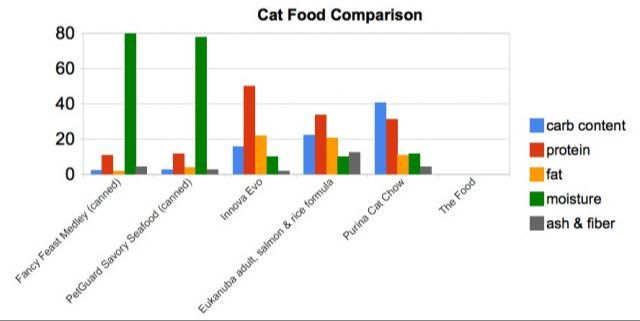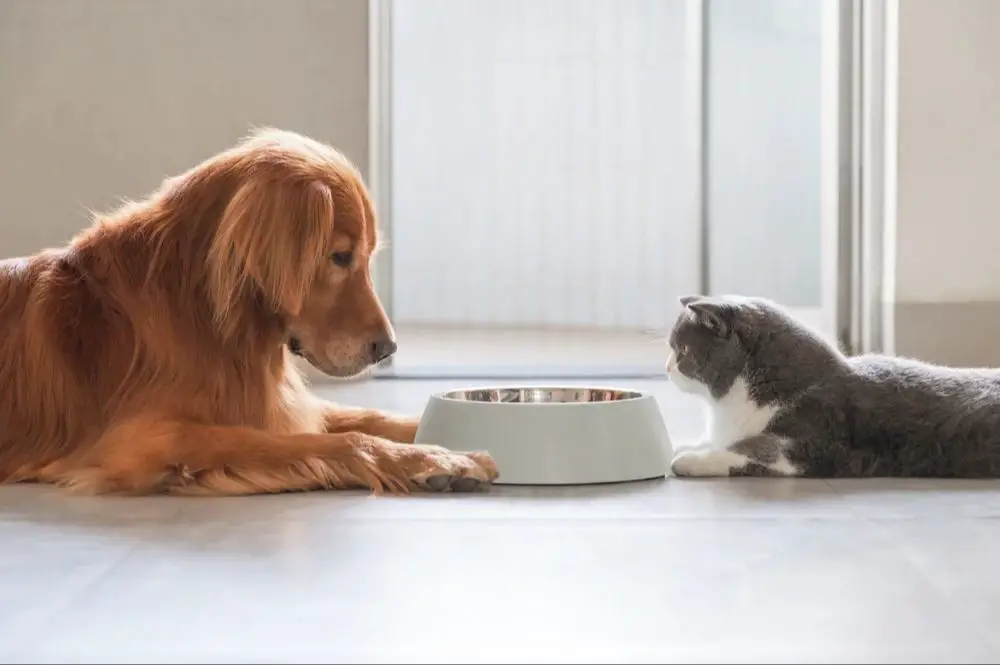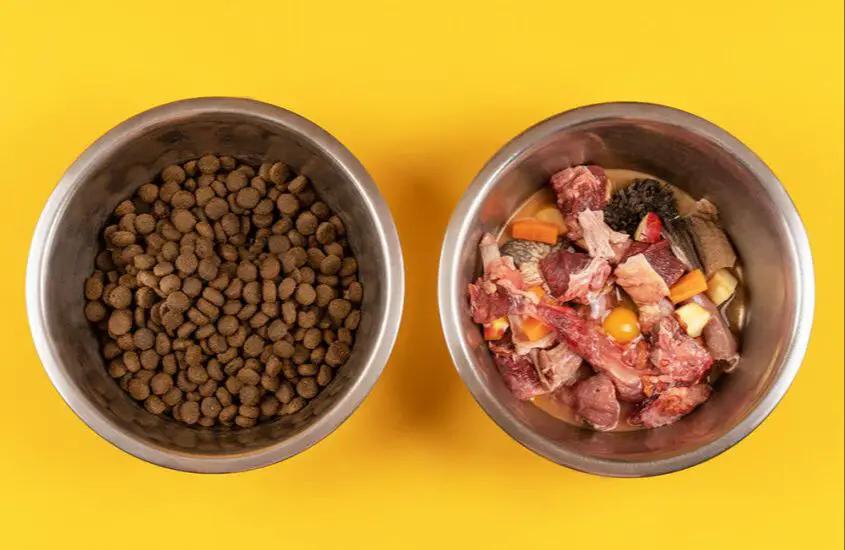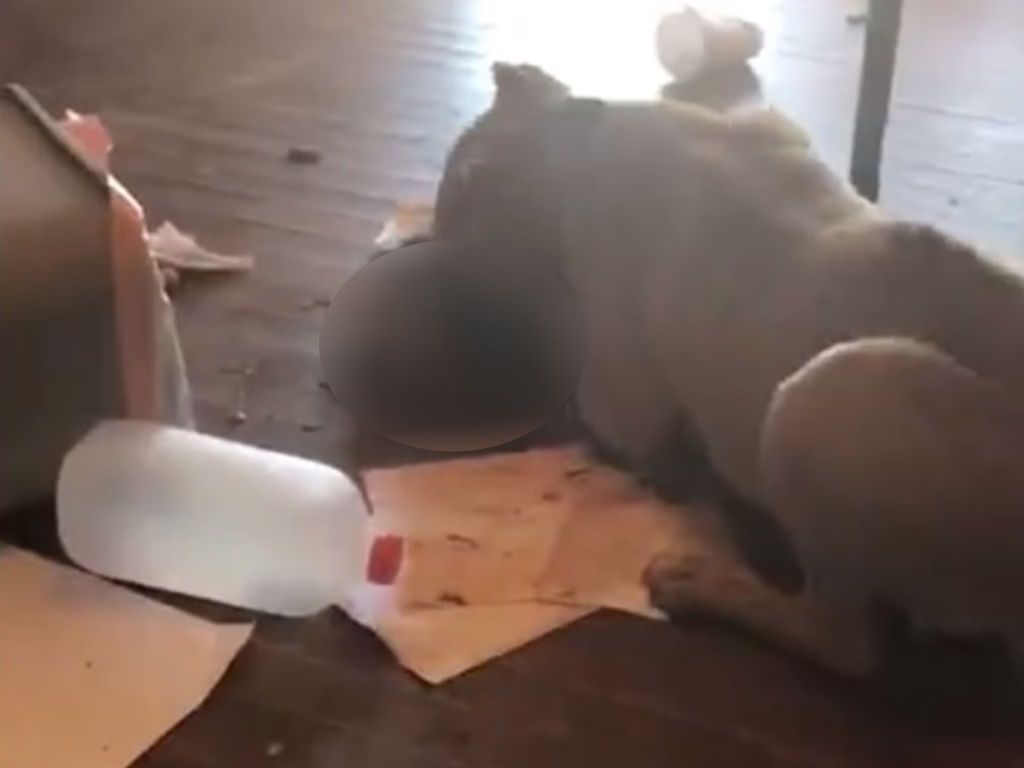Cat food and dog food are formulated to meet the specific nutritional needs of cats and dogs. While cat food may seem like an easy substitute if you run out of dog food, there are some important differences to consider before feeding cat food to dogs, even for just one meal. This article will examine the key differences between cat and dog foods, potential risks and benefits of dogs eating cat food in the short term, how to transition back to dog food, and when you should seek veterinary advice.
The key questions we will cover include:
- What are the nutritional differences between cat and dog food?
- What risks are there in feeding cat food to dogs?
- Is it okay for dogs to eat cat food for just one meal?
- How do you transition a dog from cat food back to dog food?
- When should you be concerned and contact your vet after feeding cat food?
Nutritional Differences Between Dog and Cat Food
There are some key nutritional differences between dog and cat food. According to the ASPCA, dogs have different dietary requirements than cats (source).
In terms of protein, dogs have lower protein requirements than cats. Cats are obligate carnivores and need a high amount of quality animal-based proteins. Dogs are omnivores and do well on lower protein amounts from both plant and animal sources. Cat foods often contain around 40% protein, while dog foods average around 25% protein.

For fat content, cats again require more than dogs. Cats utilize fat for energy and require almost two times more fat than dogs. Cat foods have minimum fat levels of 15%, while dog foods are around 8% to 15% fat. Cats also require a dietary source of essential fatty acids like omega-3s.
When it comes to carbohydrates, dogs utilize carbs better than cats. Most dog foods contain around 50% carbohydrates like grains and vegetables. Cat foods have a maximum of 40% carbs since too many can lead to obesity and diabetes. Dogs also have higher fiber requirements than cats.
Vitamins and minerals levels also vary between cat and dog foods based on their differing nutritional needs. For example, cats require more dietary taurine, arginine, and vitamin A. Dogs need more calcium and vitamin D. Trace minerals like zinc and copper also differ between cat and dog food formulations.
Overall, it’s important not to swap cat and dog foods due to their unique nutritional profiles. Cat foods are too high in protein and fat and too low in carbs and fiber for dogs. Dog foods do not meet cats’ high protein and other micronutrient needs.
Dangers of Dogs Eating Cat Food
While the occasional bowl of cat food won’t harm your dog, long-term feeding of cat food to dogs can pose some health risks. Cat food is very high in protein and fats and deficient in vitamins and minerals. This nutritional imbalance can upset your dog’s stomach and lead to gastrointestinal issues like vomiting or diarrhea (Can Dogs Eat Cat Food).
High-fat foods like cat food can also increase the risk of obesity and pancreatitis in dogs. Pancreatitis, an inflammation of the pancreas, can occur when a dog eats a large amount of fatty foods. This condition is incredibly painful and in severe cases can be fatal (Can Dogs Eat Cat Food).
Another risk with long-term cat food consumption is nutritional deficiencies. Cat food does not have the optimal calcium to phosphorus ratio that supports bone health in dogs. It is also deficient in vitamins and minerals like vitamin E, vitamin D, and taurine that dogs need to thrive.
Benefits of Dog Food for Dogs
Dog food is specifically formulated to meet the nutritional needs of dogs, which are different from cats in several key ways. Dog food contains optimal levels of protein, fat, vitamins and minerals that cater to a dog’s digestive system and metabolism [1].
One of the main benefits of feeding dogs dog food is that it provides balanced nutrition to support their health and activity levels. Dog food typically contains more protein than cat food to meet the higher protein requirements for dogs. The protein in dog food assists with building muscle mass, supporting skin and coat health, blood formation and other bodily functions [2].
Dog food also tends to have higher fat content to meet dogs’ higher energy needs. The fat provides concentrated calories for energy and aids the absorption of fat-soluble vitamins. In addition, dog food contains essential fatty acids that contribute to skin and coat health [2].
The fiber content in dog food promotes good digestion and regular bowel movements. Many dog foods contain beet pulp as a source of fiber. Dog food may also contain glucosamine and chondroitin to support joint health.
Feeding dog food formulated for dogs ensures they receive the right blend of nutrients they need, while avoiding deficiencies or excesses that can occur with cat food. It supports optimal health, energy and longevity for dogs.
Risks of Feeding Cat Food Long-Term
While feeding cat food for a single meal likely won’t cause major issues, regularly feeding cat food to dogs can pose some risks. Here’s why cat food should not be a dog’s staple diet:

Cat food is higher in protein and fat than dog food. The high protein and fat content can put extra strain on a dog’s liver and kidneys over time, potentially leading to organ damage. For optimal health, it’s best to feed dogs food specifically formulated for their nutritional needs.1
Cat food lacks certain nutrients that are important for dogs, such as enough taurine. Taurine is an amino acid dogs require in their diets. Dog food contains adequate taurine while cat food does not since cats can synthesize their own taurine. Deficiencies in taurine can cause heart disease in dogs.1
The vitamin and mineral balance in cat food is tailored for felines, not canines. Over time, nutrient deficiencies or toxicities can develop when feeding the wrong animal species’ food. For example, cat food is too high in vitamin A for dogs.1
Overall, while cat food may not immediately harm a dog if fed temporarily, it does not provide optimal nutrition. Vets recommend feeding species-appropriate dog food for the long term to keep your dog as healthy as possible.
Is It Okay for a One-Time Meal?
While it’s not recommended to make a habit of feeding your dog cat food, the occasional meal likely won’t cause long-term issues according to veterinarians (https://www.akc.org/expert-advice/nutrition/can-dogs-eat-cat-food/). For example, if you run out of dog food for the night and only have cat food available, it’s generally safe for an otherwise healthy dog to eat a small amount of cat food for one night only.
Focus on feeding less than 10% of your dog’s daily caloric requirements from the cat food (https://www.akc.org/expert-advice/nutrition/how-many-times-a-day-should-a-dog-eat/). This limited quantity likely won’t meet their full nutritional needs but can minimize risk of vitamin or mineral toxicity from too much cat food. Monitor your dog closely for signs of gastrointestinal upset like vomiting, diarrhea, or lack of appetite. As long as your dog tolerates the cat food without issues, resuming their regular dog food the next day should be fine.
While not ideal, eating cat food for one meal or night due to extenuating circumstances is unlikely to harm an adult dog. Just don’t make it a habit long-term. Get your dog back on dog food as soon as possible.
Transitioning From Cat Food to Dog Food
If your dog has eaten cat food, even for just one meal, it’s important to gradually transition them back to dog food. An abrupt change in diet can lead to gastrointestinal upset like vomiting or diarrhea. Here are some tips for smoothly switching your dog back to dog food after eating cat food:
Mix the cat food with dog food in increasing ratios over the course of 5-7 days. For example, mix 75% cat food with 25% dog food on day 1, 50% cat food and 50% dog food on day 2, 25% cat food and 75% dog food on day 3, and 100% dog food by day 7. This gradual transition gives your dog’s digestive system time to adapt.

Look for dog foods with similar ingredients, meat sources, and protein/fat/carb ratios as the cat food. This makes the switch easier on your dog’s stomach.
Feed smaller, more frequent meals during the transition. Give your dog’s digestive system extra time to adjust.
Keep an eye out for vomiting, diarrhea, or other signs of stomach upset. Slow the switch if needed. Consult your vet if symptoms persist more than 1-2 days.
Stick to the new dog food for at least 2 weeks after fully switching. Constantly changing foods can irritate your dog’s stomach.
Make sure your dog has access to plenty of fresh water during the transition period to stay hydrated.
Gradually transitioning back to dog food over 5-7 days is recommended after your dog eats cat food. Watch for signs of stomach upset and take it slowly. Consult your vet if concerns arise.
Signs of Illness After Eating Cat Food
If a dog eats cat food, especially in large quantities or over an extended period of time, it may lead to gastrointestinal issues or other health problems. Some common symptoms to watch for include:
Vomiting – Eating cat food may irritate a dog’s stomach and lead to vomiting. This is often one of the first signs of illness after a dog eats cat food. The vomit may contain undigested cat food particles.
Diarrhea – Cat food can disrupt the bacterial balance in a dog’s gut and lead to diarrhea. The stool may be loose, watery, or contain mucus or blood. Diarrhea is a common reaction when a dog eats something its body isn’t accustomed to.
Lethargy – A dog that has eaten cat food and is feeling unwell may become lethargic or lack energy. The dog may be less enthusiastic about exercise or play. Lethargy often goes hand-in-hand with gastrointestinal upset.
Loss of appetite – If cat food caused vomiting or diarrhea, the dog may temporarily lose its appetite. Eating cat food can throw off a dog’s normal metabolism and hunger signals. The dog may have little interest in food until its digestion improves.
According to experts at the AKC, eating cat food on occasion may lead to nothing more than vomiting and diarrhea, but this can vary from dog to dog. If your dog exhibits signs of intestinal distress after eating cat food, especially if symptoms last more than 24 hours, contact your veterinarian (source).
When to Call the Vet

If your dog shows any concerning signs or symptoms after eating cat food, even just one meal, it’s best to call your vet right away. According to the ASPCA Animal Poison Control Center (APCC), you should contact your vet or APCC at (888) 426-4435 if you suspect your pet has ingested something potentially toxic like cat food (https://www.aspca.org/pet-care/animal-poison-control). Some signs that warrant an immediate vet visit include:
- Vomiting
- Diarrhea
- Lethargy
- Loss of appetite
- Increased thirst or urination
- Abdominal pain
The ASPCA advises not to wait and see if symptoms worsen. The earlier you seek veterinary care, the better the outcome will likely be. The vet can induce vomiting if needed, provide IV fluids for dehydration, monitor kidney values, and provide supportive care. They will ask about what and when your dog ate to determine treatment (https://www.aspca.org/news/what-expect-when-calling-aspca-animal-poison-control-center). Don’t hesitate to call the emergency vet or follow up with any additional questions afterward.
Conclusion
In summary, while an occasional meal of cat food is unlikely to harm an otherwise healthy dog, there are potential risks with feeding cat food long-term. Cats require higher levels of protein and fat than dogs, so cat food lacks the balanced nutrition that dogs need. The high protein and fat content in cat food can potentially cause gastrointestinal upset, pancreatitis, weight gain or nutritional deficiencies in dogs over time. The safest option is to transition your dog back to a high-quality dog food and avoid feeding cat food for more than a night or two in an emergency. Monitor your dog closely and contact your vet if you notice any signs of illness after eating cat food. With proper nutrition from dog food and veterinary guidance, your dog can continue to live a long and healthy life.

